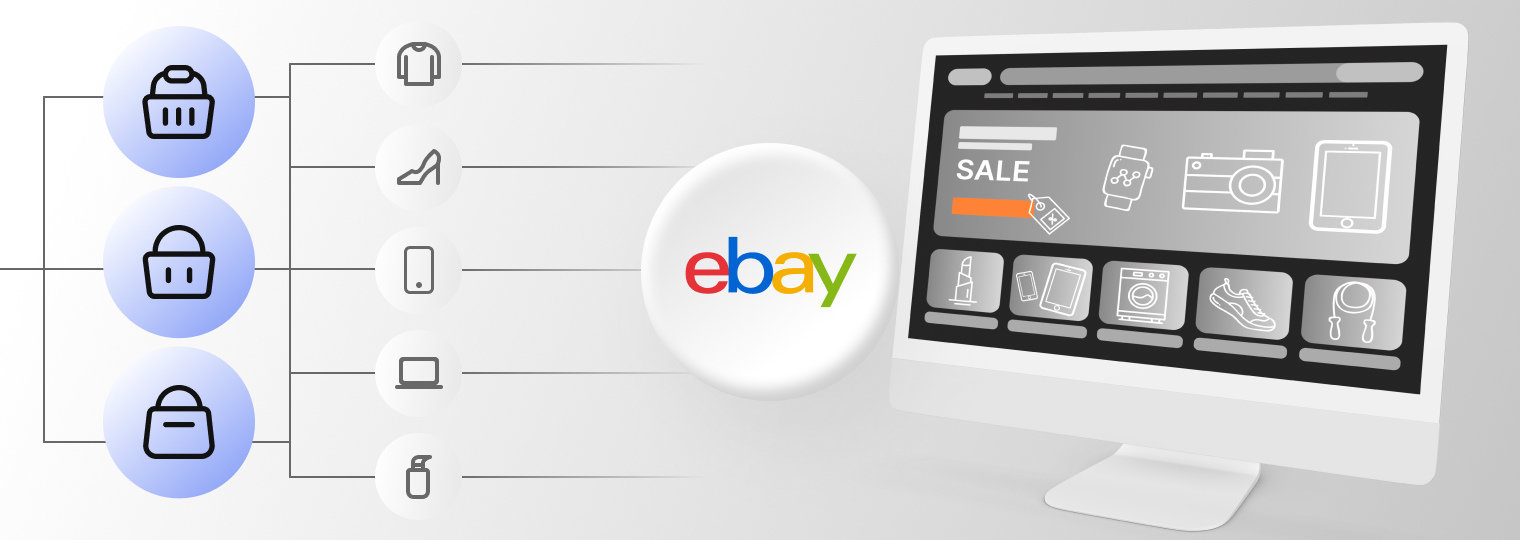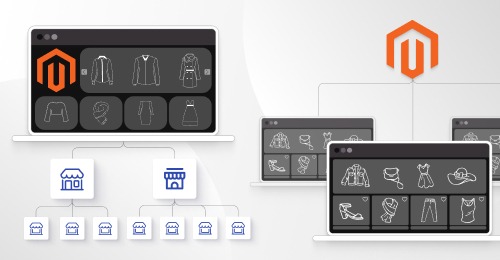The examples of giant multi-vendor marketplaces like eBay inspire entrepreneurs worldwide to try to repeat their accomplishments. Why did this business model become so popular?
A tremendous product range, low entry barriers, economies of scale, a variety of opportunities for revenue generation, easy scalability, and global reach are just some of the enticing benefits an online multi vendor marketplace platform can offer.
eBay, a trailblazer in online auctions, today boasts impressive statistics:
- 132 million shoppers worldwide;
- $2.54 billion in revenue in the second quarter of 2023.
No wonder it has become a benchmark for many industry players.
Today, armed with the valuable experience of pathfinders, businesses can attain stellar results with significantly lower effort. Building and running an eCommerce website like eBay still provides plentiful opportunities to grow.
Moreover, with the help of modern technology, the venture becomes more efficient and straightforward.
Let’s talk about eBay’s journey to prosperity, the benefits and opportunities of a bidding website like eBay, and the ways to craft a winning marketplace that would bring fruits for years to come.
- What is a Bidding Website Like eBay?
- eBay Path to Success
- Why Build a Multi-Vendor Marketplace Like eBay? Core Benefits
- Main Features for an eBay Alternative
- Steps How to Build a Website Like eBay
- What eCommerce Platform Does eBay Use?
- How to Create an Online Marketplace Like eBay for 3 Months
- How to Create an Online Marketplace Like eBay with Magento?
- Build a Website Like eBay: How Much Does It Cost?
- Conclusion: Create an eBay-Like Website
Briefly About The Main Thing
Get an eCommerce Expert Consultation
Our Adobe Business Practitioner will audit and optimize your site for robust performance.

What is a Bidding Website Like eBay?
A bidding website is an online resource where visitors can participate in auctions to obtain items. Vendors can list their products there, and potential buyers place bids on respective items. In ascending auctions, the highest bidder wins the piece and obtains it by paying the winning bid amount. In the descending auction, the bids are going in the opposite direction.
Thanks to its immense success and popularity, eBay’s model has set standards for other online marketplaces. Here’s how it works:
- Listing items. Vendors outline the items they wish to sell, accompanied with their images, initial price, and auction duration.
- Bidding. Potential buyers browse the listings and place bids on the selected pieces.
- Winning bid. When the auction finishes, the highest bidder wins the item. The winner receives the respective note with instructions on completing the purchase.
- Payment and fulfillment. The auction winner must pay the final bid amount to the seller. The shipping occurs after the payment is received.
- Feedbacks. After the transaction is completed, both shoppers and vendors may leave feedback and ratings for each other based on their experience.
An auction website like eBay offers a dynamic and competitive buying experience, as users engage in real-time bidding to obtain a desired piece.
The product categories introduced on such platforms expand beyond consumer goods and include collectables, electronics, fashion, vehicles, and many more. The auction format is exciting as it creates a sense of urgency among bidders, making it a unique way to shop online.
eBay Path to Success
To gain a holistic view of the eBay case, we’ll explore how this business was built.
eBay Journey
eBay’s story is a testament to innovation, adaptability, and the power of online marketplaces. Conceived in 1995, eBay began as a simple auction website where visitors could trade collectables. The platform’s success was rooted in its user-centric approach and its ability to create a dynamic web-based marketplace.
eBay quickly expanded its offerings beyond collectables to include a vast assortment of products, opening the service to a global audience. Its feedback and rating system has built trust among clients, establishing a foundation of reliability.
One of eBay’s key innovations was the concept of consumer-to-consumer (C2C) ecommerce, which enabled individuals to easily turn their possessions into cash by selling to a vast online audience. This democratization of commerce attracted millions of consumers seeking to gain prominence, find unique items, or start small businesses.
Recognizing the potential of the evolving internet landscape, eBay acquired PayPal, thereby expediting the payment process, enhancing the user experience, and elevating the platform’s credibility.
An iconic name in online trading, eBay inspires entrepreneurs worldwide and carries a plethora of precious insights for followers.
eBay Business Model
eBay grants a unique experience to its users.
- Shoppers can enjoy two types of pricing models: a fixed price and an auction listing. The pricing model can be adapted depending on the supply/demand balance. Ultimately, buyers can bid on their favorite pieces, and sellers increase their income.
- eBay grants significant opportunities to grow. To acquire more vendors, the resource provides flexible fees and user-friendly services. Vendors can establish their account and adjust their marketplace page to their demands.
- Sellers can settle their rules. eBay enables its vendors to master their delivery fees and return rules.
eBay Revenue Sources
The platform leverages several monetization strategies:
- Vendor fees. Sellers pay a percentage of each transaction.
- Listing fee. If sellers publish over 50 pieces per month, each extra item must be paid.
- Insertion fees. If the item appears in several categories, a vendor pays for each category.
- PayPal fees. The payment is composed of a percentage of transactions and a fixed fee.
- Advertising. Sites like eBay are tempting for advertisers, and they earn on paid placements.
- Freemium packages. Basic services are available for free, while premium services must be paid.
Is A High Abandonment Rate Affecting Your Business?
Our solution includes a new theme with a hot feature set to re-engage customers and boost sales.

Why Build a Multi-Vendor Marketplace Like eBay? Core Benefits
What can you attain if you choose to create a website like eBay? The resource benefits numerous stakeholders, including platform owners, shoppers, and vendors.
Let’s explore the specific advantages it can deliver.
1. Worldwide reach
eBay is an international resource, granting vendors access to a massive audience. This opportunity is particularly enticing if you envisage expanding your consumer base beyond your local market.
2. Increased product discovery
You can find virtually anything on eBay. With a massive product supply on the marketplace, buyers have a higher chance of discovering unique and niche pieces that might not be available on conventional retail stores.
This leads to increased sales on eBay like websites and makes them a one-stop destination for shoppers.
3. Price competition
Multiple sellers offering similar products spur healthy competition, leading to competitive pricing. Shoppers can compare prices, shipping options, seller ratings, and other conditions to make informed buying decisions.
4. Scalability and minimized inventory expenses
Sellers can leverage the marketplace’s platform and consumer audience, reducing the need for their independent ecommerce infrastructure. This is an excellent chance for new and small businesses to scale without significant upfront investment.
5. Lower entry barrier for sellers
Starting your own ecommerce store requires considerable resources. Unlike joining a multi-vendor marketplace, however, where merchants can quickly and almost effortlessly enter the market.
Furthermore, they don’t need to arrange their own website or invest in generating initial traffic.
6. Community and support
A website like eBay has an active user community, forums, and consumer support to assist users with their queries and concerns.
Furthermore, marketplaces address all technical aspects like website maintenance and security. This relieves sellers from technical hassle and enables them to focus on strategic goals.
Main Features for an eBay Alternative
When creating a multi-vendor marketplace platform, you should implement a neat suite of features to facilitate smooth interactions between parties.
Let’s discuss several primary characteristics typically encountered in such marketplaces:
1. User profiles
- Separate profiles for shoppers and vendors.
- Seller profiles showcase their pieces, ratings, reviews, and other associated data.
- Buyer profiles track their order history, wish lists, and saved searches.
2. Listings and catalog
- Vendors can compose and control their product listings.
- Items are categorized and tagged for effortless discovery.
- Product descriptions, images, prices, and delivery information are included.
3. An auction feature
When building an online marketplace like eBay, complement the conventional marketplace functionality with the ability for users to place bids.
4. Shopping cart
- Shoppers can add pieces to their shopping carts.
- The checkout is seamless and contains various payment methods.
- Secure payment gateways for transactions.
5. Reviews
- Shoppers can rate and leave reviews for products and sellers.
- Reviews contribute to vendor reputation and product quality assessment.
6. Search options
- Potent search functionality for users to navigate through thousands of products.
- Filters based on categories, prices, ratings, and more.
7. Order management
- Vendors maintain complete control over their orders, including order processing, shipping, and tracking.
- Shoppers can monitor the status of their orders and interact with sellers.
8. Seller dashboard
- Through a dashboard, vendors can administer their inventory, sales, orders, and analytics.
- The opportunity to explore performance insights, sales trends, and customer behavior data.
9. Platform’s fees
- Select your monetization strategy and implement it clearly and transparently. The marketplace can charge sellers a commission or listing fees for using its services.
- Offer automatic calculation of fees based on sales.
10. Messaging and notifications
- Inherent messaging system for communication between buyers and sellers.
- Email or app notifications for order updates, inquiries, and promotions.
11. Secure transactions
- Protect buyers’ and sellers’ financial information with secure payment processing.
- Include services to hold funds until the transaction is completed.
12. Shipping
- Integration with carriers for real-time shipping quotes and tracking.
- Options for vendors to select shipping methods and costs.
13. Multi-currency and multi-language support
Support for different currencies and languages to cater to a global audience.
14. Mobile responsiveness
Establish a mobile-friendly interface or craft a dedicated mobile app for visitors on the go.
15. Analytics and reports
Data insights for vendors and the platform owner, including sales reports, customer behavior, and popular items.
16. Marketing
- Tools for sellers to run promotions, discounts, and special offers.
- Banner placements, featured products, and sponsored listings.
17. Social sharing
Integration with social media platforms for consumers to share information.
18. Trust and security measures
- User authentication, SSL certificates, and security protocols to protect consumer information.
- Fraud prevention and user verification processes.
The choice of your particular feature set and its implementation will be dictated by your marketplace’s segment, target audience, business model, and other factors. When building your multi-vendor marketplace website, you should meticulously plan your undertaking and regard the demands and aspirations of the service’s potential users.
Steps How to Build a Website Like eBay
The industry pioneers, including eBay, have already come this way. It eases your path since you can follow their traces in certain aspects. However, today, you’ll have to cut through fierce competition when creating your multi vendor marketplace platform.
We’ve collected several vital preparatory steps you can take to lay a solid foundation for future prosperity.
1. Research the market
What does this phase entail?
- Determine your target market and segment
Competing with everyone may become overwhelming. Narrow down your focus by identifying your clientele, their needs and anticipations, and try to reveal unsatisfied demands. Spot the gaps in existing offerings to discover the space for your service’s positioning.
- Analyze competitors
Think of multi-vendor marketplaces like eBay in terms of their strengths and weaknesses. What can you borrow from them? Is there something they are not doing? Is there something you can do better?
- Define your unique value proposition
The fundamental goal of this phase is to shape your positioning that would be grounded on the unique value proposition. This is the cornerstone of your marketing strategy that would help you distinguish yourself from the competition.
2. Develop a monetization model
When crafting a multi vendor marketplace website, you should determine how your venture will operate in terms of financial streams. We have already described the eBay monetization strategy.
You are free to select your own approach based on the several models:
- Commission-based strategy. Vendors pay commission for every transaction.
- Subscription-based strategy. You establish a membership fee for using your service.
- Listing fee. Vendors pay for listing their pieces on your resource.
- Freemium strategy. You grant your users free access to some features, while advanced ones (i.e. expedited shipping) come at a cost.
To create a multi vendor ecommerce marketplace website, you can implement each approach or their combination in any convenient way. Just carefully analyze each model’s implications for your business and ensure it will operate successfully.
3. Who’s first: sellers or buyers?
When you build a multi vendor marketplace, a reasonable question would be, whom should you target first: your potential vendors or potential shoppers? There is no universal recipe.
However, you can explore several efficient approaches that would guide you to the appropriate solution.
- Start with the hardest side. Offer a certain value for one category. The accumulated supply will then trigger demand and vice versa.
- Identify your market segment. If you have properly fulfilled Step 1, you’ll have this task already done. By starting successfully with a small group of clients, you’ll be able to scale as your business grows.
- Focus on your unique value proposition. Promote your unique value proposition by offering relevant discounts and perks.
- Create a community. eBay is praised for its extensive audience of fans. Arrange live action and buzz around your multi-vendor marketplace.
- Leverage promo tricks. Invite sellers to become your agents by attracting buyers for a certain incentive. Establish restricted access to particular features, products, or categories to shape a feeling of exclusivity. Partner with a celebrity as your brand endorser.
4. Select your eCommerce platform
Multi vendor marketplace development requires a reliable eCommerce platform that would empower you to set all the desired functionality and realize the business strategy.
You are already familiar with the essential features auction websites should contain. The chosen software solution should match your business needs and ensure that the features and the entire platform will operate smoothly.
The galloping software market entices users with abundant offers, making the selection process a challenge for entrepreneurs. To ease your choice, we suggest a range of factors to base your decision on:
- Scalability. Favor platforms that offer scalability features such as load balancing, caching, and efficient database management.
- Multi-vendor functionality. The platform should have inherent multi-vendor capabilities or be easily customizable to support multiple sellers.
- Flexibility. Prioritize platforms with a strong developer ecosystem or open APIs that enable deeper customization.
- Security. Prefer platforms with strong security features and compliance with industry standards.
- Mobile responsiveness. Ensure the platform provides a seamless experience on various devices and screen sizes.
- Marketing tools. Consider inherent SEO tools and marketing features such as discounts, coupons, and integrations with social media and email marketing.
According to our experience, Magento satisfies all the criteria mentioned above and enables excellent store performance.
What eCommerce Platform Does eBay Use?
Every eCommerce business owner aspires to transform their own website into a successful and outstanding marketplace like eBay, but a lengthy path of hurdles, complications, and hazards accompanies every successful story. Let’s delve deeper to determine whether trying to duplicate eBay’s path is worthwhile, whether custom development is truly necessary, more about eCommerce software and what challenges may hide the success of the ecommerce market’s titans.
The main question: How is eBay built?
Frontend Technologies of eBay Tech Stack Include:
- HTML5 as the backbone of the web;
- CSS3: styling and formatting the appearance of eBay’s web pages;
- JavaScript: adding interactivity and dynamic content to its web pages.
- React: managing eBay’s complex and data-driven UI.
- Redux allows eBay to manage the application state in a centralized store, making tracking changes, debugging, and maintaining the codebase easier.
- Webpack optimises and bundles its JavaScript, CSS, and other assets.
- Node.js and Express are utilized to power its server-side rendering and APIs as well as to build its server-side infrastructure, enabling faster page loads and improved SEO.
Backend Technologies of eBay Tech Stack Include:
- Programming Languages: Java for its backend services, JavaScript (Node.js), and Python.
- Web Frameworks: Spring Boot for building microservices.
- Databases: Oracle and Apache Cassandra.
- Big Data & Analytics: Apache Kafka is used for real-time data streaming, and Apache Spark is used for big data processing and analytics.
- Search Technologies: Apache Solr.
- Caching: Memcached and Redis to enhance performance and reduce database load.
- Containerization & Orchestration: Docker is for containerization, and Kubernetes is for managing, scaling, and deploying these containers automatically.
- Cloud Services: Amazon Web Services (AWS) and Google Cloud Platform (GCP).
Infrastructure Technologies of eBay Tech Stack:
- OpenStack Private Cloud
- Microsoft Azure Platform Appliance
- Google Cloud Platform
- X.commerce Platform
To sum up, you need a huge tech team and budget to create a website like eBay and gain top search rankings. Motherless, a streamlined way to gain an eCommerce website like eBay exists. HOW?
There is no need for custom development of a multivendor marketplace. Planning to build your own Multi Vendor Marketplace from scratch? It seems exciting, but it’s a difficult path ahead.
Key Challenges of Custom Multivendor Store Development:
- It takes a long time. To create an online marketplace like eBay, you must last months or even years. You’re not just building a website but designing every feature from scratch.
- It’s more expensive than you think. A custom multivendor store typically costs $120-150K, but with a ready CMS, the cost is at least seven times cheaper.
- You require tech experts to build a website. To go custom, you’ll need a team of tech experts, including developers, designers, DevOps, and QA engineers.
- Maintenance. You are responsible for every problem and update. This means spending more time and money to maintain your site and keep it working smoothly.
- Integrations and Incompatibilities. Custom sites can resist integrating with other tools and services, such as payment systems or marketing applications.
Kate Odyntsova
WebMeridian Project Manager with over 5 years of experience helped us to answer some frequently asked questions about multi-vendor store development.

How to Create an Online Marketplace Like eBay for 3 Months
Only in rare cases do startups release a wholly ready and perfect product that has been worked on for several years. The most effective strategy for a new business is to launch an MVP. Let’s dig deeper into the features of the MVP multivendor marketplace and how Magento can accelerate its launch.
An MVP is a simplified version of your personalized marketplace with only the most basic features. These are some benefits:
- Market approval. Launching an MVP may validate your marketplace concept while analyzing its market potential.
- Cost-effectiveness. Prioritizing main features reduces development costs while avoiding investment in non-essential features.
- Time-to-market. Focusing on important features may reduce development time and attract people more rapidly.
- Risk management. You can test market demand and idea viability without making a significant upfront cost by launching a scaled-down version.
So, eBay chose this simplified and years-proven way. Below, you can see how its site looks at every beginning.

10 Main Features for MVP of Online Marketplace Like eBay:
1. Home Page
A unique logo space, search bar, featured categories and items, reviews, call-to-action buttons, and footer links to essential pages must all be included on the first page of your marketplace. It should provide a straightforward yet thorough introduction to the platform and direct customers to the marketplace’s primary features and categories.
2. Buyers’ and Vendors’ Account Pages.
Sellers. The issue is that information regarding an online store or vendor should be appropriately given and easily managed by the seller.
Buyers. The buyer should be aware of general store information, such as the functionality provided by the marketplace, fees charged, and privacy policies, for example.
3. Product Page
Product pages are the most popular and visited on the website. It contains the following information: outline, product information, technical specifications, consumer feedback, and warranty.
4. Registration Page
A marketplace MVP signup page should be as straightforward as possible. An excellent registration page should ideally have enough space to include many buttons that allow users to register an account and sign up using their social network profile, Google or Apple ID.
5. Search Option
Search is critical for a marketplace MVP since it allows consumers to find the desired item quickly and easily by entering a search phrase in the field.
6. Messaging
The feature enables both parties to communicate and discuss an item or service. Furthermore, they can discuss costs, payment methods, delivery, etc.
7. Payment Processing
Implementing Apple and Google Pay became incredibly popular. Furthermore, offering different payment methods, such as PayPal, Stripe, and Square, is always a good idea.
8. Reviews and Ratings
When purchasing things, you can instil confidence and trust in purchasers by using reviews and ratings.
9. Notifications
This feature improves the visitor experience and increases traffic. They notify users of new messages, order requests, special deals, etc. It signifies that users are always interested in your brand.
10. Administration Panel
It allows you (as an administrator) to monitor and handle all seller-buyer interactions. It can change information about platform users, products, and payments. Using this functionality, you may incorporate user comments and optimize the marketplace workflow locally.
It’s critical to keep in mind that an MVP should include the needs of both market segments, with a more significant emphasis on user enjoyment than the concept of “minimum.”
Okay, and there, you may have a new question: How can I create an MVP that allows the powerful launch of my marketplace? Our answer is Magento 2. Here are a few facts about how Magento enables your business to create an online marketplace like eBay, streamlined but effective.
How to Create an Online Marketplace Like eBay with Magento?
Magento is extolled for its flexibility, tremendous range of features, marketing tools, and massive storage capacity. With a market share of 1.72%, the platform falls within the top seven ecommerce platforms worldwide.
Furthermore, Magento powers over 250,000 of active websites globally and helps merchants achieve about three times faster growth than websites using the other platforms.
- Magento is widely utilized for the development of online shopping websites, presenting a flexible shopping cart system, as well as control over the look, content, and functionality of online stores. Additionally, Magento boasts robust marketing, search engine optimization (SEO), and catalogue-management tools.
- Adobe Commerce platform allows you to easily customize and extend functionality, enabling you to accommodate a variety of business models and vendor requirements.
- Magento 2 provides tools to manage orders, inventory, delivery tracking and other key aspects of multi-seller marketplace operations.
- This eCommerce software undergoes active updates and maintains a high level of security, a critical aspect, particularly when dealing with transactions and data from multiple sellers and buyers.
- Magento provides the capability to establish multi-user accounts with varying access levels, simplifying the creation of a multivendor marketplace website.
Adobe Commerce has a wide choice of ready-made modules specifically designed for marketplace development. These modules serve as invaluable tools, accelerating the development phase and providing developers with pre-built functionalities to streamline the creation of robust and efficient marketplaces.
- Marketplace Multi Vendor Module for Magento 2
- Multi-Vendor Marketplace Platinum Package for Magento 2
- Marketplace Multi Vendor Module by Webkul
- Multivendor shop
- Magento 2 Marketplace Multi Vendor Module
These shared features underscore the comprehensive nature of these modules, offering a robust foundation for the creation and management of multivendor marketplaces.
- Store Transformation: Transforming single-seller websites or Magento 2 stores into robust multivendor marketplaces.
- Vendor Management: Empowering vendors to handle product listings, inventory, orders, and profiles efficiently.
- Product Support: Support for various product types, ensuring versatility for vendors.
- Integration Capabilities: Seamless integration with major shipping and payment services.
- Mobile Accessibility: Availability for mobile platforms catering to both Android and iOS users.
- Additional Leverage for Vendors: Providing vendors with additional marketing capabilities, efficient order management, and detailed sales reporting.
- Advanced Features: Incorporating advanced features similar to industry giants like Amazon and eBay.
- Marketplace Approval System: Admin approval for vendors and products, ensuring quality control.
- Commission Management: Managing commissions for vendors on a global and individual level.
- Order Management and Reporting: Efficient order management for sellers and comprehensive reporting capabilities.
- Shipping Methods: Customizable shipping methods to cater to varying vendor needs.
Even more than necessary for an MVP, right? Sounds like the perfect solution to all your marketplace startup needs. And if it is so in reality, let’s analyse it on a real example with technical aspects, numbers, terms, and cost.
Is it possible to create a multi-vendor marketplace like eBay on Shopify?
Oleg Fediv, a Senior Shopify developer with over a decade of experience in eCommerce development and consulting, addresses 4 key questions from our clients about how to create an online marketplace like eBay. Let’s dive into the question-and-answer session to smoothly navigate in main question: “How to create a website like eBay on Shopihy?”.
Q1: Does Shopify offer the functionality to create an online marketplace like eBay?
A1: While Shopify doesn’t offer built-in features specifically for creating a marketplace, using existing tools is still feasible. There are apps available, like “Multi Vendor Marketplace – Convert your eCommerce Store to a Fully Fledged Marketplace | Shopify App Store” on the Shopify App Store, that streamline the process. Additionally, Shopify functions like a marketplace where the store owner acts as a vendor. There’s a neat feature allowing you to sell your own products within the Shopify store, accessible through a dedicated mobile application.
Q2: Is it possible to set up a separate dashboard in Shopify for each seller to set up their own payment methods, analytics, and account details separately?
A2: While Shopify doesn’t provide separate panels for each seller, you can customize accounts to access all relevant data except for payment settings. Payment information is typically managed solely by the store owner.
Get a Shopify Expert Consultation
Let our senior Shopify developer analyze your store and provide a comprehensive plan for eCommerce optimization to make your website stand out.

Q3: Is it possible to configure the marketplace so a user orders goods from different sellers, but payments are made separately for each supplier and payments are sent separately to these sellers?
A3: If a customer purchases products from multiple vendors in a single checkout, you’ll need to calculate appropriate payouts or utilize existing solutions. For instance, referral apps can display information based on the vendor or referral, or through alternative methods for the intermediary.
The process is straightforward: you install the app, and it allocates commissions according to predefined rules. For instance, if a single checkout includes purchases from three vendors, the app distributes funds to each vendor based on their respective sales. In this way, you can create a website like eBay with the same principles.
Here are some applications recommended by the developer to automate these calculations:
Q4: Can the rating and review system be customized for each seller’s products?
A4: Yes, it’s possible. With such an approach, you smoothly make an eBay website. Product reviews are typically linked to the product ID. When there are multiple identical products from different vendors, these are considered distinct products in the system, so customization for each seller’s products is feasible without issues.
Creating an Online Marketplace Like eBay: Real Timeline, Stages, and Costs
To provide the most accurate insights into the figures and enable you to structure your budget and timelines precisely, we’ll walk you through the development of a marketplace from our portfolio. While the project is bound by an NDA, we focus on sharing facts such as timeline, cost, and workflow rather than intricate details. Multivendor marketplace development in different niches and industries follows a similar process, so let’s dive deeper.
Project Intro:
Our client’s primary goal was to build a website (multivendor marketplace) promptly on a limited budget.
The functionality of the marketplace that the customer desired and the list of features that we, along with the Adobe Business Practitioner, deemed suitable for creating an MVP of an eCommerce website like eBay, are listed below.
- For Buyers
- Search and filtering
- Shopping Cart and One-step Checkout
- Reviews and Ratings
- Similar Products Offering
- Customer Account
- Order history
- Loyalty programs and discounts
- Payment (Paypal, Stripe, Adyen) and Shipping
- Convenience of the site. No more than 3 clicks to put a product on a basket
- For Sellers / Vendors
- Personal Seller/Vendor Accounts
- Unlimited Vendor Onboarding: Seamlessly onboard an unlimited number of vendors at your store.
- Agile Commission Setup: Set up vendors’ commissions with the flexibility to adapt to a business model.
- Vendor and Product Validation: Implement vendor and product validation following business requirements.
- Vendor Autonomy: Empower vendors to manage their own orders, products, and inventory.
- Comprehensive Transaction Analytics: Provide vendors with detailed analytics of their transactions for informed decision-making.
- Efficient Admin Panel: Easily manage all vendors, transactions, and payouts from a centralized admin panel.
- Product Import from Amazon and Cdiscount: Download products seamlessly from Amazon and https://www.cdiscount.com/.
- API Integration: Incorporate APIs for collecting products, ensuring a streamlined process.
Utilizing Magento 2, we successfully developed a fully functional MVP of a multivendor marketplace within 3 months. The key trick in adeptly configuring ready-made solutions, specifically extensions that seamlessly accelerate the process. In this case, we fine-tuned the following extensions:
Implementing this functionality took us the following amount of time:
| Our Service | Timeframe |
|---|---|
| Design | 100 hours |
| Front-end Development | 250 hours |
| Back-end Development | 300 hours |
| DevOps | 40 hours |
| QA (through the entire project) | 90 hours |
This clearly illustrates that development of a fully functional marketplace is entirely possible within the range of 700–850 hours. This basic feature set provides a robust fundament for a successful launch. After post-market validation and gathering customer feedback, you can progressively enhance and add extra features to your online marketplace like eBay.
Note that custom development isn’t always the sole solution. The WebMeridian team enables you to efficiently create an eCommerce website within a short timeframe and a planned budget, leveraging our extensive experience in utilizing ready-made solutions to make a site like eBay.
Build a Website Like eBay: How Much Does It Cost?
We have already analyzed the technical nuances of creating an online marketplace, but there is one question – how much does it cost to create an online marketplace like eBay?
To put it short, the development of an online marketplace like eBay varies from $29,000 to $40,000 and higher. The total costs required to build an eCommerce site, as we described above, are the following:
| Development Stage | Timeframe, hours | Average Rate, $ | Total Costs |
|---|---|---|---|
| Design | 100 | 30 | 3000 |
| Front-End Development | 250 | 35 | 8750 |
| Back-End Development | 300 | 40 | 12000 |
| DevOps | 40 | 30 | 1200 |
| QA | 90 | 25 | 2250 |
| PM | 100 | 25 | 2500 |
| 880 Hours | $29700 | ||
The cost of developing an online marketplace can always be reduced if you apply to credible, competent, and trustworthy partners with solid portfolios and ratings that speak for themselves. To give you an idea, here’s an estimate of the marketplace website cost across different regions in 2023 (based on Clutch rates):
- Central Europe – $41,200 (based on $50/h)
- Eastern and Western Europe – $82,400 (based on $100/h)
- USA- $123,600 (based on $150/h)
- Australia – $82,400 (based on $100/h)
For the most accurate cost estimation tailored to the online marketplace architecture, it’s recommended to approach a certified software development company. A proficient team will generate an estimate based on your specific needs, offering comprehensive consultation on the final product and the development process.
Conclusion: Create an eBay-Like Website
Building an eCommerce multivendor marketplace is a beneficial yet challenging venture. The experience of industry giants, such as eBay, urges many entrepreneurs to try to repeat or surpass their achievements. Indeed, following the beaten path seems easier than becoming a trailblazer, while the stories of your predecessors’ triumphs sound inspiring.
However, the contemporary environment poses plentiful challenges to daring merchants. To assist you in their mitigation, we have compiled this list of the primary steps toward a successful multivendor marketplace solution and the fundamental features it should comprise.
Some of your core strengths include the opportunity to learn from others’ experiences, access to helpful technologies, and the availability of trustworthy partners who can simplify the whole development process for you.
With our 7+ years of experience with Magento, technical prowess, and solid domain expertise, we can handle your project from the ground up.
Entrust creating your multi vendor ecommerce marketplace to us and make your path smooth and results – impressive! Just leave a request!



